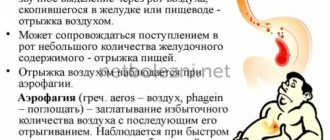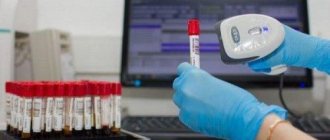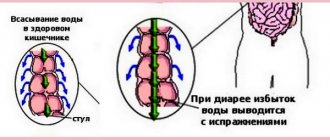The article was prepared by a specialist for informational purposes only. We urge you not to self-medicate. When the first symptoms appear, consult a doctor.
The phenomenon of diarrhea and vomiting without fever in children is observed quite often. It is quite natural that such a condition of the child causes anxiety among parents, especially if he is still very young.
Vomiting and diarrhea will not always indicate some serious illness, however, only a doctor can adequately assess the situation. Of course, parents should know the possible causes of the child’s condition, but this does not mean that they do not need to see a doctor.
Causes of vomiting and diarrhea in a child without fever
Often parents are too careless about vomiting and diarrhea in their children, if the body temperature remains normal. This is explained by the fact that adults are accustomed to the temperature against the background of any disease. However, it is worth considering that some pathological conditions can occur without this symptom. It is possible that the child has a reduced immune system or even has diseases of the immune system. As a result, the body's defenses do not respond, and the body temperature does not rise.
It is also worth remembering that in infants the symptoms of many diseases are blurred, and the deterioration of the condition occurs much faster than in older children. Therefore, in just a few hours, the baby can fall into a serious condition that is life-threatening.
Vomiting and diarrhea without body temperature in children can occur for the following reasons:
Intestinal infection
The most common intestinal infections in childhood are rotavirus infection, dysentery, salmonellosis, and escherichiasis. They can occur without fever, but it is possible to increase body temperature to subfebrile levels, and in some cases to high values.
Vomiting and diarrhea have the following characteristics:
- Vomiting does not depend on food intake and can be one-time or more frequent.
- Vomit consists of the food that the child has eaten.
- Viral infections are characterized by loose, watery stools.
- Bacterial intestinal infections are characterized by mucous stools with foam and a strong odor.
- Diarrhea with intestinal infection prevails over vomiting.
In addition, the following symptoms are characteristic of an intestinal infection:
- Severe cramping pain in the abdomen.
- Restlessness of the child, which, as diarrhea and vomiting intensify, will be replaced by drowsiness and lethargy.
- Refusal of water and food.
- As the disease progresses, increased body temperature may occur.
- Symptoms of dehydration: sunken eyes, dry eyes, lack of urination, sunken fontanel (in infancy), convulsions. These symptoms should never be ignored.
Treatment of intestinal infections in children under one year of age is carried out only in a hospital setting. If the child is older than one year, then the issue of hospitalization is decided depending on the severity of the patient’s condition.
Therapy consists of the following main activities:
- Prescription of antitoxic drugs - enterosorbents.
- Prescription of nitrofurans, furazolidone.
- Eliminating the cause of vomiting and diarrhea: antibacterial or antiviral therapy.
- Parenteral rehydration therapy.
- Elimination of symptoms of the disease: lowering body temperature, relieving pain.
The final stage of treatment is rehabilitation therapy with the administration of probiotic drugs.
Food poisoning
Food poisoning in childhood most often occurs from either dairy products or breast milk. Juices, fruit and meat purees, both home-made and factory-produced, are also dangerous.
Features of vomiting and diarrhea due to food poisoning:
- Repeated, exhausting vomiting that occurs soon after eating.
- Frequent stools with an unpleasant odor and blood.
- Diarrhea and vomiting may stop quickly, but the patient's condition will worsen.
Other symptoms of food poisoning:
- Abdominal pain is severe and occurs as spasms.
- The child's moodiness, which, as the disease progresses, gives way to lethargy and drowsiness.
- The patient refuses food and water.
All children with suspected food poisoning are subject to hospitalization (under 3 years of age). As for older children, the issue of inpatient treatment is decided depending on the severity of the patient’s condition.
Treatment of food poisoning comes down to the following points:
- Gastric lavage.
- Prescription of nitrofurans, furazolidone.
- Purpose of enterosorbents.
- Carrying out parenteral rehydration therapy.
- Prescription of anti-inflammatory drugs, antispasmodics.
The course of treatment for food poisoning always ends with restorative therapy with the administration of probiotics.
Dysbacteriosis
Vomiting with dysbacteriosis occurs infrequently, no more than 1-2 times a day. The stool is unstable, constipation is replaced by foamy diarrhea. Other symptoms of dysbiosis are: loss of appetite, rumbling and pain in the abdomen after eating, white coating on the tongue. Skin reactions are possible, but do not always occur. These include rash, itching and dry skin.
Treatment of dysbacteriosis is outpatient. To begin with, the child is offered nitrofurans for intestinal sanitation, then, against the background of nutritional correction, the intestinal microflora is restored with the help of eubiotics and probiotics.
Allergic reaction
Vomiting and diarrhea without fever may occur due to an allergy to a food product or drug. In younger children, such a reaction often occurs to the first complementary foods.
Vomiting begins soon after feeding and contains undigested food debris. In addition, the child develops itching, hives and other skin reactions. Severe allergies are accompanied by swelling of the mucous membranes of the nose and throat, and breathing problems.
Treatment depends on the severity of the allergic reaction. In mild cases, therapy is carried out at home. Antihistamines, enterosorbents and hormonal drugs are prescribed (in severe cases).
Causes of diarrhea in an infant
Teeth coming through can cause diarrhea.
There are cases when you can independently rid a child of an illness such as diarrhea, but some situations require medical intervention. Below are the main causes of diarrhea in infants:
- Nutrition for a nursing mother. It happens that after using some new product, a mother notices changes in her child’s stool. Diarrhea can be caused by eating fresh fruit, vegetables, herbs, or too fatty foods. Treatment is limited to correcting the feeding mother’s diet and eliminating the “provocateur product” from the diet.
- Baby food. Cases when a child experiences diarrhea due to dietary habits: an allergic reaction to an adapted formula; start of complementary feeding (4-6 months); consumption of a previously unfamiliar product; untimely introduction of the product (the child’s digestive system is formed gradually, so it is advisable to introduce the products, following the advice of the WHO); insufficient amount of enzymes. This problem can also be solved by adjusting the diet.
- Lactase and gluten deficiency. This problem is a child’s intolerance to cereals and dairy products. Recently, such cases have become more frequent; children do not have enough enzymes necessary to digest this kind of food. If the problem of lactase deficiency arises during breastfeeding, then the mother needs to exclude dairy products from the diet, and if with artificial milk, transfer the baby to low-lactose adapted formulas. If you have gluten deficiency, you need to exclude cereals such as wheat, semolina, barley, as well as bread, buns, cookies and other baked goods from your baby’s diet. Signals for testing for lactase and gluten deficiency (in addition to constant diarrhea) are skin rashes and insufficient weight gain in the baby. The problem of milk intolerance may disappear on its own after the baby is four months old, as his body will be prepared to produce the necessary enzymes required to digest mother's milk.
- Teething. When a baby gets a new tooth, he may experience diarrhea. There is no need to treat it; after the tooth hatches, the problem will disappear. Reasons: excessive secretion of saliva and its entry into the gastrointestinal tract, impaired peristalsis, weak immunity, infection in the intestines, irritated intestinal walls.
- Intestinal infection. This is the most common cause of diarrhea in infants. It is not at all difficult to get an intestinal infection, since the baby puts everything that comes to hand into his mouth, so it is important to monitor the cleanliness of foods and objects that are accessible to his eyes. In a mild form, such an infection is not dangerous and goes away on its own in a short period of time. If everything is much more serious, then you can observe an elevated temperature and severe diarrhea. An intestinal infection can cause acute diseases such as dysentery, amoebiasis, salmonellosis, etc. These diseases lead to fever, vomiting, critical dehydration, and weight loss. If you have such signs, you should immediately consult a doctor. In particularly difficult situations, you will have to go to an infectious diseases hospital.
- Dysbacteriosis. The very concept of dysbiosis does not imply a specific disease; it is a kind of violation of the proportions of beneficial microflora to pathogenic ones. Dysbacteriosis in infants is very common, which is explained by the incompletely formed organs of the digestive system. There is debate about whether it is worth taking measures for a child who is 2-3 months old? Some doctors prescribe taking probiotics, which should restore the balance of the intestinal microflora, while others are convinced that the baby’s gastrointestinal tract is immature for natural reasons, so interfering with the microflora of a child under 12 months is more likely to harm than benefit.
- Congenital intestinal pathologies. This phenomenon is very rare, but it still occurs. Acute surgical pathologies: appendicitis, peritonitis (inflammation of the abdominal cavity), intussusception (gastrointestinal obstruction). Symptoms of acute pathologies: sharp pain in the abdominal area, elevated body temperature, vomiting, bloating. You should not put off visiting an ambulance if your baby has similar symptoms.
Causes of vomiting in a child without fever
The causes of vomiting in a child without fever can be very diverse, most of them are presented in the table:
| Disease | Character of vomiting | Associated symptoms | Therapy |
| Reflux esophagitis |
|
|
|
| Pylorospasm |
|
| An operation that is performed when no effect is observed from fractional feeding and physiotherapy. |
| Pyloric stenosis |
|
| Only surgical treatment. |
| Gastritis, duodenitis. In infants, the disease most often develops from taking medications, and in older children from eating new exotic foods. |
|
| Therapy involves changing your diet. Portions should be small, drink frequently and plentifully, but in small doses. Drug therapy depends on the child's condition. |
| Intestinal diverticulum. |
| Loss of body weight. | Treatment is only surgical. |
| Intussusception. The introduction of one section of the intestine into another in children under one year of age most often occurs due to illiterate introduction of the first complementary foods, and in children at an older age due to infection with pinworms, due to intestinal polyps or tumors. | Initially, the child develops an acute attack of pain, after which vomiting of bile begins. |
| Treatment is only surgical. |
| Diseases of the digestive organs (gallbladder, liver, pancreas). |
|
| Treatment is carried out in a pediatric gastroenterology department. The child is prescribed a special diet. Depending on the type of disease, enzyme drugs, hepatoprotectors, and antispasmodics are prescribed. |
| Diseases of the central nervous system, including ischemia and hydrocephalus (for newborns), brain tumors and increased intracranial pressure (for children after one year). |
|
| Depending on the specific lesion of the central nervous system, treatment is carried out either at home or in a hospital. Drugs are prescribed to improve cerebral blood supply, or surgery is performed. |
| Ingestion of a foreign body. |
|
| Depending on the situation, either surgical treatment or observation of the child is indicated until the foreign body comes out through the intestines. |
Another pathology in which vomiting without fever is observed is appendicitis. But with appendicitis, vomiting will be only the first sign of the onset of inflammation, and after a few hours the body temperature will still increase.
Children from 0 to 5 years. When should you urgently take your child to the doctor?
We all get very worried when a child gets sick; We are also afraid that he will certainly be sent to the hospital. And the children's hospital, as you know, is like this: you get in with one thing, you get out with another. This is why mothers often refuse hospitalization or postpone a visit to the doctor, hoping that the disease will go away on its own; others prefer online consultations on forums and advice from grandmothers and friends.
Fortunately for all mothers, in most cases modern medicine makes it possible to make a diagnosis and provide the necessary assistance very quickly, resorting to hospitalization only as a last resort. Something like in the famous series with Hugh Laurie - MRI, and all the necessary tests, and CT, and, most importantly, competent pediatricians and highly specialized specialists. Unfortunately, such a set is not available in all clinics, but in one place in Moscow there is definitely one - in the emergency pediatrics department of the Federal State Institution "National Medical Research Center for Children's Health" of the Russian Ministry of Health, where doctors usually need no more than 2 hours to establish an accurate diagnosis, taking all the necessary tests and quickly receive their results, stabilize the child and send him home if there is no threat to life and indications for emergency hospitalization.
If you understand that your child needs prompt consultation with a specialist, but for some reason you put off a visit to the doctor, if you are afraid that the child will be immediately sent to the hospital ward “to clarify the diagnosis” or will not receive proper attention, just come to the emergency pediatrics department of the Federal State Institution “National Medical Research Center for Children’s Health” of the Russian Ministry of Health. Here they immediately do all the necessary research and provide assistance to the child as efficiently and quickly as possible. Every year, more than 3,000 children receive care in the department, and only 2% of them are hospitalized by doctors in a 24-hour hospital. The rest are sent home after all necessary procedures are completed with appropriate recommendations, or they will be observed for several days in a day hospital. The department accepts children without an appointment, works on compulsory medical insurance, voluntary medical insurance and on a commercial basis.
If your child is between 0 and 5 years old, do not neglect visits to the doctor because your child is at risk. It is at this age that most serious diseases occur, which are well studied by medicine, are well treated, but require prompt medical intervention. Tatyana Vladimirovna Kulichenko, head of the department of emergency pediatrics of the Federal State Institution "National Medical Research Center for Children's Health" of the Ministry of Health of Russia, Doctor of Medical Sciences, pediatrician of the highest category, WHO expert, spoke about in what cases it is worth immediately contacting specialists for young children (we are talking about children first 5 years of life).
High temperature (fever)
To begin with, it is important to determine what fever is from a doctor’s point of view. Fever is an increase in body temperature to more than 38 ºC if measured rectally (preferably, as this is the most reliable way to determine body temperature in any person), and more than 37.5 ºC if measured in the axilla depression
Not every fever is a very bad sign, but with children under three years of age it is better to play it safe and see a doctor as quickly as possible. There are no legislative “terms of patience”; There is no need to wait three days, as pediatricians usually say: all the most severe infections develop very quickly and can be threatening from the first hours of illness. The sooner you contact a specialist, the better it will be. Examination of the child, instrumental and laboratory tests will help to understand the cause of the fever and quickly stabilize the child’s condition.
If just an elevated temperature does not seem to you to be a sufficient reason to see a doctor, then pay attention to the symptoms of intoxication:
- The child refuses to drink (not eat, but drink).
- Lethargy and drowsiness are observed, it is difficult to establish eye contact with the child (some pediatricians talk about such patients as “the child looks into himself”).
If a child begins to develop a skin rash along with an increase in body temperature, then you should go to the doctor immediately.
Cough
Cough is a fairly common symptom in children. It is precisely because it seems to be a common, “understandable” sign of illness that parents often skip the moment of timely contacting a doctor. A cough can be caused not only by problems with the respiratory system. It can signal problems in the cardiovascular or digestive systems. It can even be caused by a wax plug in the ear. Until you eliminate the cause, the symptom will not disappear!
Take your child to the doctor immediately if:
- The child is less than 6 months old (it does not matter if he has a fever or other symptoms).
- The child has a night cough.
- The child coughs until he vomits.
- The cough does not go away for more than 3 weeks.
- A cough of a “barking” nature, such a cough is often accompanied by hoarseness and noisy breathing.
Difficulty breathing
Any difficulty breathing can be a life-threatening symptom, especially in children in the first year of life. How to understand that breathing is difficult in a baby: when inhaling, a retraction is visible along the edge of the costal arch (the child seems to strongly draw in his stomach when breathing). Difficulty breathing in older children can be noticed if there is no fluency of speech: the child cannot speak in long sentences (as a rule, this is obstructive bronchitis or asthmatic conditions).
Take your child to the doctor immediately if you notice signs of difficulty breathing, especially if he or she is grunting, groaning, or you hear wheezing or whistling sounds when breathing, even from a distance.
Vomiting, diarrhea (diarrhea, loose stools)
These symptoms are often associated with simple conditions known to all of us, which are caused by extremely unpleasant, but in modern conditions, with proper treatment, not life-threatening intestinal infections. But if the child is not given special solutions for rehydration and the amount of fluid lost is not correctly replenished, then vomiting and loose stools are dangerous because they lead to rapid dehydration and electrolyte disturbances due to the loss of water and salts.
It happens that loose stool is not a serious problem if it happens, for example, once. If you observe it more than 3 times a day, this is a reason to sound the alarm, especially if you notice the first signs of dehydration:
- Decreased frequency and volume of urination. If your child has not urinated for 5 hours, consult a doctor immediately!
- Dry skin and mucous membranes: there are fewer tears and saliva, the skin has become dry and unusually flabby.
- Thirst.
When to take your child to the doctor immediately:
- The child refuses to drink (does not want to drink, despite being very dehydrated).
- The child stops urinating (break is more than 5 hours).
- The child is lethargic, capricious, and is not interested in toys (even if there is no fever).
- The eyes or fontanel “sink” (this happens rarely, but it is a serious symptom).
- There is blood in the stool (even if there is no diarrhea).
Skin rashes
A skin rash is always not normal. If the rash is accompanied by an increase in temperature, this is always a reason to urgently consult a doctor. There are children who have been diagnosed with skin diseases (for example, atopic dermatitis or psoriasis), in which case parents have usually already been taught how to behave if the rash worsens or the skin process worsens. Then you need to go to the doctor if the previously recommended measures are ineffective - and you will most likely go to an allergist or dermatologist, i.e. to a specialist you know. But if the rash appears for the first time, if the rash is not associated with clear provoking factors, this is a reason to consult a doctor. Not all rashes are a sign of a serious illness, but a clear diagnosis from a specialist will reassure you and allow you to quickly deal with the problem.
Pain
Pain is always a symptom of anxiety, which the human body uses to signal danger. An intense and growing pain symptom is always a reason to contact a specialist. Remember that if a child is “teething”, this may cause the child to be moody and irritable, but in the vast majority of cases it does not cause a temperature rise above 37.5*C or severe pain. Therefore, you should not attribute the symptoms that appear to teething.
How to understand that a child is in pain:
- The child cries and does not calm down.
- Unmotivated excitability.
- Anxiety (the child cannot find peace or a comfortable position).
Head injuries and loss of consciousness
Very often, parents consult a doctor only when the injury leaves traces (hematoma, swelling). If a child falls from a certain height (even if you did not see what exactly he hit) or he hits his head, do not be lazy to immediately go to a specialist. Not every head injury can go away without a trace, and, most importantly, you may not see the internal damage that occurred during the injury.
An episode of loss of consciousness, “going limp” or convulsions is always a reason to consult a doctor immediately.
You can read more about the Department of Emergency Pediatrics of the National Medical Research Center for Children's Health on the official website >>>
Causes of diarrhea in a child without fever
The causes of diarrhea without fever in a child may be the following:
- Intestinal infection, minor poisoning.
With an intestinal infection, diarrhea is frequent, on average it happens up to 5 times per knock. If a child has poisoning, then there will be no foreign impurities in the stool, but if there is an intestinal infection, then the stool may have a non-standard color and mucous consistency. Since intestinal function is disrupted, particles of undigested food will be present in the stool. In addition to diarrhea, the child will experience abdominal pain, and the tongue will be covered with a white coating. Probably a rash. As for treatment, it depends on the severity of the intestinal infection or poisoning. In mild cases, the child remains at home.
- Allergy to a drug.
Diarrhea manifests itself a couple of hours after taking the medicine. In addition, there may be skin reactions. Treatment boils down to stopping taking the drug.
- Enteritis.
Inflammation of the small intestine is characterized by severe diarrhea up to 6 times per knock. The stool is greasy with food particles. The pain is localized in the navel area, appetite disappears. Treatment is carried out at home.
- Parasitic infection of the intestines.
The stool is unstable, diarrhea gives way to constipation. The child loses body weight, abdominal pain similar to colic is possible, and sleep is disturbed. Increased drooling and lethargy may occur. Treatment boils down to prescribing anthelmintics.
- Dysbacteriosis.
The stool is foamy, has an unpleasant odor and occurs up to several times a day. In this case, there is bloating, loss of appetite, and abdominal pain occurs a couple of hours after eating. Sometimes skin reactions appear, the tongue becomes covered with a dense white coating. Treatment at home.
It should be remembered that diarrhea without fever can also develop with other, more serious diseases. Therefore, if diarrhea does not go away after a day, then consultation with a specialist is required.
Causes of vomiting and diarrhea without fever that are safe for a child’s life
Vomiting and diarrhea without an increase in body temperature do not always indicate serious problems with the child’s health. Often these two symptoms simply accompany the natural physiological states of children.
Only vomiting (without fever and diarrhea) can occur in a child for the following reasons:
Physiological regurgitation
An infant may vomit milk or formula. However, his health does not deteriorate, his body weight remains within normal limits. Children burp up to 20 ml at a time. The discarded contents consist of curdled milk without foreign impurities.
The causes of physiological regurgitation may be the following:
- Large amounts of food.
- Incorrect posture of the baby during feeding.
- Imperfection of the digestive tract of infants.
- Incorrect nipple latching.
To reduce the frequency of regurgitation, the baby should be held with his head slightly elevated during feeding. After eating, you need to put the baby in an upright position for 15 minutes. This will allow excess air to escape. It is equally important to monitor the amount of food that an infant consumes.
Teething
Vomiting when the first teeth appear is not associated with food intake, its volumes are insignificant, and no cyclical behavior is observed. It happens due to the baby crying during feeding, which is explained by sore gums. At the same time, when screaming, children swallow too much excess air. Also, you should not force your child to eat while he is teething.
You can help your child in the following ways:
- Massage the gums with your finger or using a teether.
- Apply a gel with an anesthetic component to the gums.
- Avoid force-feeding if the child does not want to eat. Incorrect introduction of complementary foods
Vomiting due to improper introduction of complementary foods occurs once and does not harm the child’s health. It is explained by the fact that the body either does not accept the new product, or that the enzymatic system is not yet able to cope with the introduced components.
If vomiting occurs, the new product should be excluded from the child’s menu for several weeks or more. After this time, you can offer it again, but in small quantities.
Psychogenic vomiting
Neurotic vomiting is typical for children over the age of three. It occurs as a reaction to a certain stress factor.
Common causes of psychogenic vomiting are:
- Parents insisting that their child eat
- The child has experienced strong positive or negative emotions, including resentment or anxiety.
- The child is very worried before any important event for him.
If a child experiences episodes of psychogenic vomiting, it is necessary to protect him as much as possible from a stressful situation and consult with a child psychotherapist.
How can I help my child?
Symptoms of general intoxication should alert you
If diarrhea and vomiting in a child occur against the background of any infection, antibacterial treatment is needed that effectively affects pathogens. But you need to exercise maximum caution so as not to damage the body’s microflora and not destroy natural biodefense along with the infection. In case of improper treatment, other symptoms may arise; this line is very easy to break, and restoring the microflora is a very labor-intensive task, even for doctors.
Do not forget that when treated with antibiotics, toxins also enter the body. Therefore, it is necessary not to stop the absorption of toxins into the blood, but only to limit the intake. There are substances such as Enterosorbents that reduce the intake of toxins, thereby the child’s condition noticeably improves. A proper diet can also help in the treatment of diarrhea and vomiting, since these symptoms remove a lot of fluid and useful components from the body, you need to take care of its nutrition.
It will be necessary to increase the number of servings of food and reduce the volume. If the baby is less than a year old, breastfeeding should be done more often than usual. You need to feed him the same milk as before the disease, only now you need to add a special solution to the diet, from 50 to 110 ml. This is done after regular vomiting or diarrhea.
If the baby is not accustomed to lactation through a bottle, you can feed him with a teaspoon or even a syringe without a needle. If after you give him something to drink, he wants more, do not refuse him, let him drink as much as he wants, the body must replenish the lost fluid. If, while feeding the child, the intake of milk is accompanied by subsequent vomiting, then you need to continue to feed, but now slowly and in small portions. When this does not help for several hours, the situation does not change for the better, then seeking the help of a doctor will be a mandatory measure.
For children who are over one year old and no longer eat only milk, the diet should remain the same, but you can add more meat, vegetables, flour and fermented milk products, such as yogurt.
It is better to eat foods such as banana, rice, apples or mashed potatoes in the first days of the disease. But sugary drinks and all sweets must be completely avoided; they can cause diarrhea and vomiting. In the first hours after detecting diarrhea or vomiting in a child, you need to give him a special solution to drink, 50 ml per kg of the child’s total weight. Subsequently, the dose should be taken after each vomiting or loose stool in an amount of 12-130 ml.
What can you give your child for vomiting and diarrhea?
Since vomiting is not an independent disease, but a symptom of poisoning of the body, or a sign of some kind of infection, antiemetic drugs should not be offered to a child. Stopping vomiting with the help of antiemetics will only worsen the child’s condition, since all harmful substances will remain inside and be absorbed into the blood. If the cause of vomiting is not food poisoning, you cannot self-medicate. It is necessary to seek help from specialists as soon as possible in order to prevent serious problems with the child’s health.
To stop diarrhea, you should not give your child antibacterial intestinal drugs (Enterofuril, Levomycetin, Loperamide (Imodium), Furazolidone), since most often they will not have a therapeutic effect. Statistics indicate that in the vast majority of cases, diarrhea in childhood is caused by a viral intestinal infection, food poisoning, or overeating. In each of the three cases, antibiotics will not help! In addition, stopping diarrhea, like vomiting, will cause harmful substances to stay longer in the body and continue to poison it from the inside.
Most likely, parents who independently gave their child an antibiotic for vomiting and diarrhea will claim that both of these symptoms stopped 1-3 days after starting to take the medicine. However, it is known that a viral intestinal infection goes away on its own during this period, which means taking antibiotics was unjustified and unnecessary. In case of poisoning, diarrhea stops after all harmful substances are eliminated from the body. Therefore, antibacterial therapy does not have a positive effect on the course of the disease.
However, you can help your child’s body cope with infection and poisoning by offering him probiotics and enterosorbents. The action of the first drugs is aimed at destroying viruses, and the second at binding harmful substances and preventing them from entering the blood. Therefore, in case of food poisoning, the child is given enterosorbents, and in case of intestinal infection, probiotics.
If the child is very small and is breastfed, then he is allowed to be given Enterosgel, probiotics Linex and Bifidumbacterin. When a child is over two years old, he can already take the following sorbents: White Coal, Enterosgel, Filtrum and Smecta. After two years, diarrhea can be eliminated with a drug called Enterol.
Recovery after vomiting
The primary task facing parents is to restore electrolytes and lost fluids. The child is not given antiemetic drugs, but for diarrhea they are offered either enterosorbents or probiotics, depending on the cause of the disease.
Lost fluid is restored using special saline solutions, which can be purchased at a pharmacy. The most famous of them are Regidron and Regidron Bio, but you can also buy the drugs Disol and Trisol. If you can’t visit a pharmacy, you can make your own saline solution. To prepare it you will need a liter of boiled water, a teaspoon of salt, five teaspoons of sugar. It is necessary to ensure that the sick child constantly drinks this liquid, but in small sips.
As soon as the attack of diarrhea or vomiting ends, you need to give the child water or saline solution. You should not wait for the medicine to work. If vomiting recurs, then water is offered again. Infants are placed to the breast as often as possible and given additional water during feeding. Older children are fed boiled vegetables, rice, lean meat, and are offered kefir or other fermented milk product. Food is given in small portions. Until the end of the illness, children can be on the BRNS diet (lamb, rice, apples and crackers). Liquid must be supplied to the body during breaks in food (at least 60 ml for infants, at least 100 ml for children after 2 years). If a child drinks the required volumes of liquid, but asks for more, then you should not refuse him this.
During vomiting and diarrhea, carbonated drinks and juices, chicken broth and milk, as well as rice water are strictly prohibited. All these fluids will aggravate the course of the disease by dehydrating the body.
When should you call a doctor?
If vomiting and diarrhea are persistent and do not stop for 4 hours, then you should call a doctor so that he can adequately assess the child’s condition. Hospitalization may be required, as persistent vomiting often indicates meningitis, a concussion, or other serious pathology.
Situations in which calling a local doctor or ambulance is mandatory:
- Three or more episodes of vomiting, one after the other, in less than three hours.
- The child’s refusal not only to eat, but also to drink liquids.
- Everything that the child eats and drinks comes out in vomit.
- Lack of tears while crying.
- The child is drowsy and lethargic, he has dry lips and eyes.
- The vomit contains blood.
- Complaints of headaches, as well as neck muscle tension and loss of consciousness.
- Suspicion of poisoning.
Other episodes of vomiting and diarrhea, as a rule, can be successfully stopped by taking the above medications and adequately replenishing lost fluid and electrolytes.
Signs of a serious illness in your baby
The sudden appearance, literally an hour ago, of a completely healthy baby, diarrhea and vomiting is already enough to seek the help of a doctor. If the child’s condition is already critical, the best solution would be to call an ambulance at home. These 2 symptoms can most likely indicate the presence of a serious infection in the child’s body that needs to be eradicated; the sooner, the easier it will be. In the early stages, the doctor will be able to diagnose the cause of the symptoms much faster and begin taking measures to eliminate it. A doctor’s help with these symptoms will be needed in the following cases:
- If the baby is less than 3 years old (this measure is extremely necessary if he has not reached six months of age)
- When the child’s body temperature reaches +38 degrees and above
- If there is blood in your baby's stool
- In case of regular, profuse diarrhea that does not stop throughout the day
- Vomiting continues more than several times
- Deterioration of appetite or its complete absence, refusal to accept the body with subsequent vomiting of everything, no matter what he drinks or eats
- The child is crying, and the lips and eyes are dry, at the same time the eyes are sunken, and the state has become lethargic, drowsiness may occur
The fact is that symptoms such as diarrhea in a child can occur even when he is completely healthy. It’s just that children under 3 years old eat mostly soft foods, so the stool can also be quite liquid. But it is important to pay attention to whether there is mucus, blood or other suspicious discharge.
Causes of vomiting and diarrhea without fever that are safe for a child’s life
- Errors in nutrition.
If a child's diet is not balanced, then diarrhea can develop at any age. In this case, loose stools containing undigested food particles appear. Often parents are able to independently identify the relationship between diarrhea and a certain product. This diarrhea is explained by the imperfection of the digestive system of children. To avoid such situations, it is necessary to correctly introduce the first complementary foods and limit children to carbonated water, chips, sweets, etc.
- Psychogenic diarrhea.
Diarrhea of a psychogenic nature, as a rule, happens once and occurs against the background of emotional shock. This is how the child’s vegetative system reacts to stress. To exclude such situations, it is important to protect the baby as much as possible from traumatic situations. A one-time prescription of an antidiarrheal drug and the introduction of a short diet without milk and fatty foods is possible.
- Indigestion or overfeeding the child.
Vomiting and diarrhea will occur immediately after eating and will contain particles of undigested food. The frequency of diarrhea and vomiting does not exceed two times. A new food product (this is especially true for exotic products), the introduction of complementary foods, or too large amounts of food can lead to indigestion. To help the body cope with vomiting and diarrhea, it is necessary to remove inappropriate products from the child’s menu and ensure an adequate drinking regime.
- Severe emotional shock.
An episode of vomiting and diarrhea due to emotional stress in children usually occurs once. This is how the autonomic nervous system reacts to shock. In order to prevent such situations, you need to create a comfortable psychological environment for the baby and eliminate stress from his life. You can offer a drug for diarrhea and vomiting. This must be done once.
- Acclimatization when changing climate zones.
Vomiting and diarrhea are likely to develop in the first two days of the child being in a new climate zone. This is explained by the body’s adaptation mechanisms to new conditions. To eliminate unwanted symptoms, you need to provide the child with maximum rest, not give him new foods and refuse physical activity.
Author of the article:
Alekseeva Maria Yurievna |
Therapist Education: From 2010 to 2016 practicing physician at the therapeutic hospital of the central medical unit No. 21, the city of Elektrostal. Since 2016 he has been working at diagnostic center No. 3. Our authors









